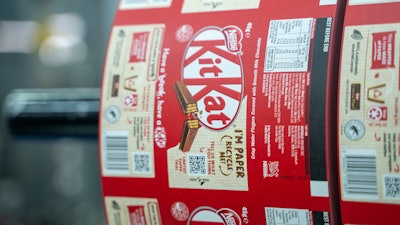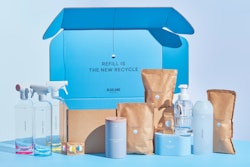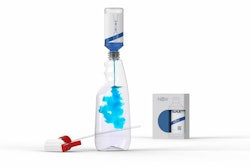We’ve been keeping an eye on a localized spate of big confectionery brands in Australia swapping out traditional mixed-plastic flow-wrap film for what they say is curbside recyclable paper-based material. Mars Wrigley Australia’s new pack film format consists of 86% sustainably sourced FSC-certified paper, plus a thin (enough) plastic liner as a barrier layer. Not to be outdone, Nestlé Oceania’s KitKat is trialing a paper-based material using an on-pack QR code to invite consumer feedback on disposal habits for the curbside recyclable pack. These recent announcements follow similar Nestlé and Mars Wrigley paper-based confectionery pack rollouts in Europe over the past few years.
Are you sensing a trend? So is Bob Lilienfeld, a packaging consultant and executive director of SPRING (Sustainable Packaging Research, Information, and Networking Group), an online community of experienced, science- and fact-based packaging professionals pushing for a more circular, sustainable packaging future.
Lilienfeld posted the Mars Australia article on his popular LinkedIn page, predictably garnering a flurry of follower reaction ranging from praise to consternation. Seeing this activity unfolding online, I asked Lilienfeld about it. For his part, he’s taking an interested, but even-keeled approach.
“I’m a skeptic,” he told me. “Before I say ‘hey, this is a great move,’ tell me what the greenhouse gas savings are. Let’s see whether it actually improves—not the recyclability per se—but the actual collection, and then the actual conversion of these wrappers back into new materials … In my ideal world, the switch to this substrate would reduce the greenhouse gas generation over its entire lifecycle, versus having that package made out of plastic. And that’s whether or not the plastic is recycled.”
Variables that factor into this ideal-world preference are numerous, making a life cycle analysis (LCA) a complex endeavor (much less two LCAs to compare the new paper pack with the legacy plastic film). But Lilienfeld looks to two primary considerations. First is the LCA information “from cradle to cupboard; or more appropriately for a candy bar that’s immediately consumed, from cradle to conversion,” he says, possibly coining a new phrase. That involves everything from extracting materials from the earth—either as trees for paper or fossil fuels for plastic—to the actual conversion of the material into a printed roll of candy bar wrapper film.
Assuming differences between packaging, supply chain, and consumption variables of the two pack formats are negligible, the next consideration is disposal of the pack after the candy bar has been eaten. “What happens if it goes into a landfill?” he asks. “You can claim all the recyclability you want here, but a significant amount of these are going to landfill … And even if they do go into a recycling bin, is the paper material recovered and converted into a new material? Is the plastic liner removed? Used as waste to energy? There are a lot of possibilities, but from the point of diversion forward, what does the environmental profile look like for the plastic format versus this package?”
A couple of other notable observations Lilienfeld shared got me looking at the several paper-based candy bar packaging projects in a new light. For one, on-pack brand presence is reduced on the paper-based Mars bars. “Only a company like Mars, which has incredible brand equity, could actually pull something like that off,” he says. In a way that a newcomer to a crowded, vibrantly colored candy aisle couldn’t, Mars has the luxury of being able to sacrifice some on-pack branding space in favor of building a family of products (Mars, Snickers, and Milky Way) that all signal “sustainability” to consumers via a natural, kraft paper appearance.
Also, candy has a unique quality that it perhaps only shares with beer and spirits—food waste is negligible and doesn’t come into play in an LCA. As long as the candy bars aren’t sitting for months in inventory outside of temperature exclusion ranges, they move fast off of shelves, and are quickly and entirely consumed, often before the consumer even gets home.
And given candy bars’ quick and on-the-go consumption quality, I wonder if waste disposal becomes more a function of available recycling receptacles? If I’m buying a Snickers bar in a recyclable flow wrapper, it’s never making it to my home curbside recycling bin since it’s not making it home with me to begin with.
I’m with Bob. It’s interesting to follow these big brand decisions, but let’s wait and see.



























